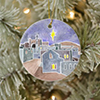 Advent is designed to help us prepare for the birth of the Savior, and there’s no better way to do that than with a Jesse Tree.
Advent is designed to help us prepare for the birth of the Savior, and there’s no better way to do that than with a Jesse Tree.
A Jesse Tree is a traditional way of marking the days of Advent – like an Advent calendar, but it traces the family tree of Jesus from Creation to the Nativity. Each day features a different Scripture passage featuring depictions of Jesus’ ancestors or events in the Old and New Testament that point to Him.
It is so named from the prophecy in Isaiah 11:1: “But a shoot shall sprout from the stump of Jesse, and from his roots a bud shall blossom.” Artists’ depictions of the Jesse Tree usually show a tree rising out of a recumbent Jesse of Bethlehem, the father of King David, with branches featuring Jesus’ ancestors as recorded in the Gospel of Matthew and the Gospel of Luke.
(Fun fact: The Jesse Tree is where our representation of a genealogical family tree comes from.)
The Jesse Tree connects our holiday traditions, like putting up a Christmas tree or lighting an Advent wreath, with the history of salvation. On the tree we place ornaments representing the people, the prophecies and events leading up to Jesus’ birth – for example, a burning bush for Moses or a ram for Isaac. There are many variations in the number of ornaments and subjects, with simple sets suitable for very young children to elaborate collections of more than two dozen ornaments.
Making a Jesse Tree is easy. You can use a small Christmas tree, a large branch or a poster as the base on which to hang the ornaments. Find daily Jesse Tree reflections and Scripture verses online – three recommendations are listed below. Each day during Advent, make an ornament to illustrate that verse and hang it on the Jesse Tree.
This activity is particularly fun for families and children, but it’s also good for anyone who wants to connect the Advent season with God’s faithfulness across history.
— Patricia L. Guilfoyle, editor





More online
 At holyheroes.com: This Cramerton-based company has a generous collection of free resources in its “Advent Adventure” collection, including Jesse Tree ornament downloadable printables, and daily emails with prayers and short videos explaining each Scripture verse so kids can watch while decorating their ornaments. Bonus free content includes printable ornaments and videos explaining the “O Antiphons.” Holy Heroes also offers for sale a Jesse Tree poster with stickers to post on your fridge, and a Jesse Tree “History of Salvation” Advent Activity Book with coloring pages, puzzles, quizzes and more.
At holyheroes.com: This Cramerton-based company has a generous collection of free resources in its “Advent Adventure” collection, including Jesse Tree ornament downloadable printables, and daily emails with prayers and short videos explaining each Scripture verse so kids can watch while decorating their ornaments. Bonus free content includes printable ornaments and videos explaining the “O Antiphons.” Holy Heroes also offers for sale a Jesse Tree poster with stickers to post on your fridge, and a Jesse Tree “History of Salvation” Advent Activity Book with coloring pages, puzzles, quizzes and more.
 At www.loyolapress.com: Find a series of online reflections for each day of Advent using a Jesse Tree, taken from “The Stories of the Old Testament: A Catholic’s Guide” by Jim Campbell. Each day’s reflection includes links to the Bible verse along with an ornament suggestion. Perfect for older children and adults who want to take a “deeper dive” into Scripture.
At www.loyolapress.com: Find a series of online reflections for each day of Advent using a Jesse Tree, taken from “The Stories of the Old Testament: A Catholic’s Guide” by Jim Campbell. Each day’s reflection includes links to the Bible verse along with an ornament suggestion. Perfect for older children and adults who want to take a “deeper dive” into Scripture.
 At www.catholicculture.org: Find more Jesse Tree ornament ideas for little children, coloring activities, even cookie recipes! Search “Jesse Tree” on the homepage.
At www.catholicculture.org: Find more Jesse Tree ornament ideas for little children, coloring activities, even cookie recipes! Search “Jesse Tree” on the homepage.
Don’t miss this!
 Advent begins on Sunday, Nov. 28, and that date also marks the start of the Church’s liturgical year. Advent (from, “ad-venire” in Latin or “to come to”) is the season encompassing the four Sundays (and weekdays) leading up to Christmas. As you prepare for the season, check out these other stories on catholicnewsherald.com:
Advent begins on Sunday, Nov. 28, and that date also marks the start of the Church’s liturgical year. Advent (from, “ad-venire” in Latin or “to come to”) is the season encompassing the four Sundays (and weekdays) leading up to Christmas. As you prepare for the season, check out these other stories on catholicnewsherald.com:
- “10 facts about Advent”: The season of Advent developed in the Church over time. Here are 10 facts that you may not know about the roots and meanings of the season.
- Blessing for an Advent wreath and Christmas tree: Information from the USCCB on blessing your Advent wreath and Christmas tree
- “The Great ‘O’ Antiphons of Advent”: The Great “O”Antiphons are brief prayers that are chanted or sung from Dec. 17 to 23.
 The Great "O"Antiphons are brief prayers that are chanted or sung from Dec. 17 to 23. The origin of these prayers is not certain, but it is probable that they were composed in the seventh or eighth centuries when the monks put together texts from the Old Testament. The Church in Rome and the monastic communities throughout Western Europe chanted the "O" Antiphons during Evening Prayer, also known as Vespers.
The Great "O"Antiphons are brief prayers that are chanted or sung from Dec. 17 to 23. The origin of these prayers is not certain, but it is probable that they were composed in the seventh or eighth centuries when the monks put together texts from the Old Testament. The Church in Rome and the monastic communities throughout Western Europe chanted the "O" Antiphons during Evening Prayer, also known as Vespers.
Each antiphon begins with the acclamation "O" followed by a different title for the Messiah. In the Middle Ages it was traditional to ring the great bells of the church each evening as the "O" Antiphons were sung.
Today, in the Liturgy of the Hours, the Magnificat is preceded by one of the "O"Antiphons that links the prayer to the feast of the day or season of the year. In the last seven days of Advent, the antiphons are very special. Each begins with the acclamation "O" and ends with a plea for the Messiah to come. As Christmas approaches the cry becomes increasingly urgent.
It is interesting to note that the first letter of each antiphon – Sapientia, Adonai, Radix, Clavis, Oriens, Rex, Emmanuel – when read backwards forms an acrostic in Latin: "Ero cras." This can be understood as the words of Christ, responding to His people’s plea, saying, "Tomorrow I will be there."
Saying the "O" Antiphons as a family – during grace at meals, in front of the manger scene or the Christmas tree – is a wonderful Advent devotion and a time to read, meditate and reflect on the Scriptural texts which form the basis for the "O" Antiphons.
- Dec. 17 – O Sapientia: "O Wisdom you come forth from the mouth of the Most High. You fill the universe and hold all things together in a strong yet gentle manner. O come to teach us the way of truth."
- Dec. 18 – O Adonai: "O Adonai and leader of Israel, you appeared to Moses in the burning bush and you gave him the Law on Sinai. O come and save us with your mighty power."
- Dec. 19 – Radix Jesse: "O Stock of Jesse, you stand as a signal for the nations; kings fall silent before you whom the peoples acclaim. O come to deliver us, and do not delay."
- Dec. 20 – O Clavis David: "O Key of David and scepter of Israel, what you open no one else can close again; what you close no one can open. O come to lead the captive from prison; free those who sit in darkness and in the shadow of death."
- Dec. 21 – O Oriens: "O Rising Sun, you are the splendor of eternal light and the sun of justice. O come and enlighten those who sit in darkness and in the shadow of death."
- Dec. 22 – O Rex Gentium: "O King whom all the peoples desire, you are the cornerstone which makes all one. O come and save man whom you made from clay."
- Dec. 23 – O Emmanuel: "O Emmanuel, you are our king and judge, the One whom the peoples await and their Savior. O come and save us, Lord, our God."
— The Crossroads Initiative: A Ministry of Dr. Marcellino D’Ambrosio, online at www.crossroadsinitiative.com.

